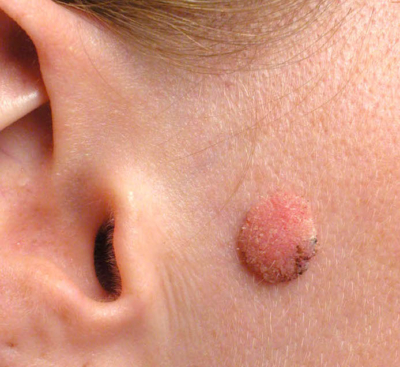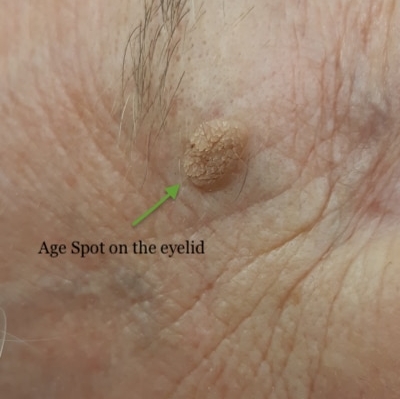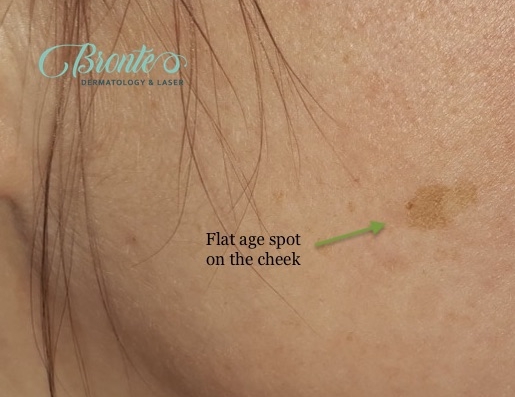Treatment of Benign Skin Lesions
Removal of moles, and benign lesions
Moles
Moles are a subtype of skin lesions which originate from specific cells called melanocytes. When we are born the precursor of moles are under our skin, however the majority of moles appear later in life. As we grow moles become at first darker until they reach to their maximum colour. Then they start to lose their colour and become more raised. This is the time that most poll fine the mole to be bothersome or annoying.
 They can catch to the clothing or become irritated easily. Not all moles become raised.
They can catch to the clothing or become irritated easily. Not all moles become raised.  Some moles stay flat and dark. Moles have the potential to turn into cancerous moles. It is very important to have your moles checked by a physician prior to any procedure to make sure it is benign. If an abnormal mole is removed by mistake and not tested t can delay the diagnosis of a life threatening condition. So never have your mole or any skin lesion removed by anyone without having it checked by a physician in advance. Also keep in mind moles are dynamic lesions. It means they can change from a normal to an abnormal mole. Hence, being told that a mole is fine, does not mean it will be fine forever. Fortunately, the majority of moles are benign and never turn into something serious. If you have a benign skin lesion, skin tag or mole and you want to have it removed, we can help you. You may require treatment to decrease its size or complete removal. We have a variety of treatments including surgical removal, laser therapy and cryotherapy we can recommend. We will be happy to see you for a consultation and discuss the best course of action.
Some moles stay flat and dark. Moles have the potential to turn into cancerous moles. It is very important to have your moles checked by a physician prior to any procedure to make sure it is benign. If an abnormal mole is removed by mistake and not tested t can delay the diagnosis of a life threatening condition. So never have your mole or any skin lesion removed by anyone without having it checked by a physician in advance. Also keep in mind moles are dynamic lesions. It means they can change from a normal to an abnormal mole. Hence, being told that a mole is fine, does not mean it will be fine forever. Fortunately, the majority of moles are benign and never turn into something serious. If you have a benign skin lesion, skin tag or mole and you want to have it removed, we can help you. You may require treatment to decrease its size or complete removal. We have a variety of treatments including surgical removal, laser therapy and cryotherapy we can recommend. We will be happy to see you for a consultation and discuss the best course of action.
Seborrheic keratosis (Age spot or Liver spot)
We also treat other benign skin lesions such as benign keratosis (or seborrheic keratosis commonly known as aging spot or liver spots). Age spots could be flat or raised. Their colour is variable from light brown to black. Again, it is difficult for regular people to tell the difference between an age spot and something more serious. Many skin lesions resemble others and only an experienced physician can tell the difference after examination. Some families have more than the others. They appear mostly because of aging process but also sometimes due to sun exposure. Unlike moles they are benign and do not turn into something more serious.
If left untreated they keep growing and will become larger and thicker. They can reach to significant size and very unsightly. It is easier to remove them when they are small. Different ways of treatment are available. The most come one is called cryotherapy of freezing using liquid nitrogen. Freezing will kill the keratosis cells and lesion will scab and fall off within 2 to 4 weeks. Sometimes, the treated lesion will no disappear completely and will require touch up. This is more common when the primary keratosis or age spot is thick and large. It is important to set up a follow up treatment in that case. There is also electrodesiccation and curettage. This is commonly referred to as electeric needle. In most cases, it requires freezing using a local anesthetic such as lidocaine. The undesired age spot or keratosis or mole will be burned off and then scrapped off during the same session. After treatment there is a small superficial sore on the skin at the site of keratosis which generally heals within few weeks. Sometimes we use laser for treatment of age spot, specially when they are flat. Laser treatment is more gentle but it takes more treatments to remove the lesion completely.


Skin tags
Skin tags are skin growth which are attached to the skin surface via a neck. They are benign and do not turn into something serious. People commonly develop skin tags around the neck, on the armpits, upper chest or in the groin. They are more common in overweight and diabetic people. Although ,having skin tag does not require to be tested for the latter. If left untreated, they will grow in size and number. There are over the counter skin tag removal kits which are only good if you have a very small skin tag. They do not work for medium or large size tags. In addition, you may develop an infection if they are not used properly. Skin tags can be treated easily. First the surface of the skin is disinfected. Then using a local anesthetic the root of the tag is numbed. Afterwards, the tag is removed from the root. There is minor bleeding which requires a quick hemostasis. The treatment area will heal quickly in 1-2 weeks depending on the size of the lesion. We can also use electric needle (electrodesication) or freezing (cryotherapy). Some skin tag, specially around the eyes and on the eyelids require more gentle removal to avoid damage to the thin skin of the eyelids. We have all the tools and experience required to remove skin tag no matter the location.
Other benign skin lesions : Prominent Sebaceous Glands (oil glands), Fibroma on the nose, etc.
Sebaceous glands are normal oil glands which are found on the skin. They are more common on the face (particularly forehead, nose and cheeks) and genitals. They are benign and doe not turn into a more serious lesion. Angiofibromas are benign skin lesions which can also be found commonly on the nose. As we age, the size of some of the sebaceous glands increases and they become more visible particularly on the face. Angiofibroma or fibromas also start to appear. Some people develop tens of them. Some medication can cause them, as well. They could be quite unsightly. They can be removed using variety of techniques. Some of them require touch up treatment to completely go away. Sebaceous glands and fibromas are located under the skin and in are cases removal can leave a small depression in the skin. Although, most people heal nicely.
So if you would like to have a benign skin lesion assessed and removed, please contact us. You do not need a referral letter from your family doctor for removal of the above lesions. You can directly contact us and we will be happy to help you.